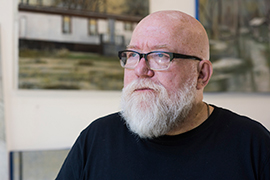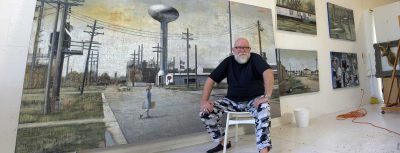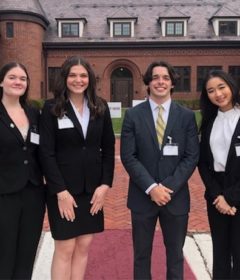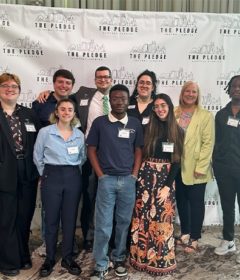Bolding Expression


Gary Bolding, professor of art, began this project 20 years ago – and he’s still not finished. But arts patrons can see – and hear – Bolding’s comedic bent and his now sly, now bold sense of satire at play in that project, in the exhibition “Vaselina Springs and the Arkie DeLeons – Faculty Focus on Gary Bolding.”
The exhibition – in the Hand Art Center through Oct. 22 – includes a gold-painted deer’s head vowing revenge on hunters, and paintings that recall, in both style and content, those fundamentalist Christian comic book tracts by Jack Chick.
But there’s more. A CD of 10 rock-flavored songs, written by Bolding and recorded with his musician buddy Ed Nicholson, is available for listening while viewing the paintings. Both the music and visuals depict life in a mythical southern Arkansas town called Vaselina Springs (pronounced vay-sah-LEE-nah). Performed by the Arkie DeLeons (Bolding, Nicholson and other musicians), the songs illuminate the paintings and vice-versa. Each is littered with characters and imagery steeped in Pentecostal Christianity: the Holy Ghost, Eden and the Fall, snake handlers, speaking in tongues, Cain and Abel.

That cross-play heightens the narrative feel of the Vaselina Springs material and makes it more of a trans-media project than a multimedia one.
And, while the current exhibition is not a works-in-progress affair, neither is Bolding finished with Vaselina Springs, which was inspired by his life growing up in El Dorado (pronounced el-doe-RAY-doe), Ark. A second CD, already recorded, focuses on race rather than religion. Also, a novella, video and a local performance by the band are in the works. The CD is on sale at the Hand Art Center.
Bolding, who has taught at Stetson since 1989, reflects on religion, the Beatles, the “personal mojo” of that deer’s head and more in this interview.
Q: You have fun in a number of your works past and present (a 2002 painting depicts Boy Scouts holding the severed head of Pablo Picasso in front of a My Little Pony Unicorn). How important is humor — whether silly, surreal or satirical — when you create?
A: In this project it’s paramount, but not in every project. “Vaselina Springs” is a dark comedy. It’s important to me that the music be serious even if some of the lyrics are satirical or darkly comedic. I didn’t want it to be that kind of “Ahab the Arab” novelty thing, or like the parodies of Weird Al Yankovic. I think some of the songs are actually poignant.
There are several other parts that aren’t in this show. One of them is a novella in which the manager of the band, the Arkie DeLeons, writes letters to Taylor Swift, Quentin Tarantino and other celebrities. They’re nothing but trying to get people to laugh.
Q: An age-old question: Which came first, the paintings or the music?
The music. The music started probably back in the mid-1990s, but back then there was no idea of Vaselina Springs. I wrote some songs which I do just for my amusement, and I was playing with another Stetson professor, Bill Nylen (political science department chair), and recording them on a cassette recorder (laughs).
I started to realize these songs were related: One of these characters was the mother of another, that kind of thing. It really started forming its own attachments.
The visual stuff is really quite recent. All of the stuff at Hand (Art Center) and most of the stuff in my studio is really from the last 12 months. I’ve been killing myself the last year.
Q: You studied at the Art Students League of New York and the New York Academy of Art. What is your music background?
A: The first record I bought was “Meet the Beatles” when I was in the third grade and we lived in Memphis, Tenn. That was my introduction to art, in a way. It was popular art, but it really was an immersion in a kind of art for the first time. I was just like every other kid in America: I wanted a guitar and I got a guitar and eventually learned how to make some racket. But I never took any lessons.
In college I felt like I had to make a decision: Do I want to do this or that? I wound up studying art and going to New York and studying painting. I became a hobbyist guitar player but I always wrote songs.
This whole “Vaselina Springs” thing started because I was visiting up in Arkansas and my friend Ed (Nicholson), who’s a wonderful musician who has played with a lot of people, said we should put some of this stuff down. We got carried away.
Q: Was there an a-ha moment to paint these songs?
A: It started to seem like this was a rich vein of material to mine. I started liking the idea of having a story that jumps from one medium to another. It’s not like the images are just illustrations for the songs or subservient to the songs. In some cases, the threads of the story are in visual media and some in audio, and then some are carried forth in text, although there’s not any text in this show. The story is told across media. I thought it would be fun to try to do it.
Q: There are a lot of references in both the paintings and the music to Southern fundamentalist/Pentecostal Christianity. Is this drawn from your direct experience?
No. I was not raised Pentecostal, but I was raised Southern Baptist. It’s to some extent based on experience and observation. In this piece the focus is religion and religious hypocrisy and abuse of religious authority, using religious authority almost as a weapon.
Q: Speaking of all the religious references and that hunter’s deer head plaque: Were you concerned about blurring the line between using Southern tropes and falling into Southern stereotypes?
A little bit. I definitely didn’t want to get too Minnie Pearl or “Dukes of Hazzard.” At the same time, my life experience reflects some of the stereotypes people think about the South. I’m concerned with crossing the line of self-mocking. I do occasionally edit something I think is too much Dogpatch. There is a line I try to avoid, but it’s a comedy so it’s an exaggeration.
By the way, that’s a deer my father killed some time in my childhood. And a lot of those frames came from my stepmother’s house after she died. So a lot of this stuff literally has a personal mojo to it that I like. It’s not just something I bought on eBay. That is a south Arkansas deer. This is very much familial history almost, but it’s all exaggerated.
-by Rick de Yampert



